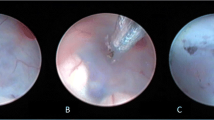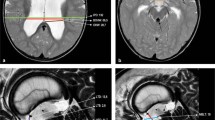Abstract
Background
Overdrainage in shunted patients is a known predisposing factor for the formation of hygromas, but little is known about risk factors in endoscopic third ventriculocisternostomy (ETV).
Materials and methods
We retrospectively analysed data of 34 patients younger than 1 year with obstructive hydrocephalus, undergoing ETV, with respect to incidence, management, outcome and possible risk factors for the formation of hygromas. Hygromas were arbitrarily defined as a collection of cerebrospinal fluid of more than 10 mm in diameter over the paramedian hemispheric convexities, diagnosed by ultrasonography.
Results
They occurred in 9 of 34 (26%) patients 3 to 28 days after ETV. They were on the operated side in four and bi-lateral in five cases. There was no relevant age difference between patients with hygromas (median 127 days) and those without hygromas (median 166 days). Etiology of obstructive hydrocephalus had no impact on the frequency of hygromas. Hygromas occurred somewhat less frequently when a paediatric endoscope with an outer diameter of 3 mm was used for ETV instead of an endoscope with a diameter of 6 mm. Hygromas were asymptomatic and conservatively managed in five cases; 4 of 34 (12%) patients underwent surgery because of clinical symptoms of increasing intracranial pressure or increasing hygroma diameter. Two patients were treated with a temporary external drainage only and another two patients with an external drainage first and eventually a subduro-peritoneal shunt. There were no neurological long-term sequelae.
Conclusion
Clear predisposing factors for the formation of hygromas could not be identified, but the outer diameter of the endoscope may play a role.


Similar content being viewed by others
References
Balthasar AJ, Kort H, Cornips EM, Beuls EA, Weber JW, Vles JS (2007) Analysis of the success and failure of endoscopic third ventriculostomy in infants less than 1 year of age. Child’s Nerv Syst 23:151–155
Beems T, Grotenhuis JA (2002) Is the success rate of endoscopic third ventriculostomy age-dependent? Child’s Nerv System 18:605–608
Beems T, Grotenhuis JA (2004) Long-term complications and definition of failure of neuroendoscopic procedures. Child’s Nerv Syst 20:868–877
Beni-Adani L, Siomin V, Segev Y, Beni S, Constantini S (2000) Increasing chronic subdural hematoma after endoscopic III ventriculostomy. Child’s Nerv Syst 16:402–405
Boschert J, Neff W, Schaible T (2002) Endoskopische Ventrikulozisternostomie im frühen Kindesalter. Päd 8:232–240
Buxton N, Macarthur D, Mallucci C, Punt J, Vloeberghs M (1998) Neuroendoscopic third ventriculostomy in patients less than 1 year old. Pediatr Neurosurg 29:73–76
de Ribaupierre S, Rilliet B, Vernet O, Regli L, Villemure JG (2007) Third ventriculostomy vs ventriculoperitoneal shunt in pediatric obstructive hydrocephalus: results from a Swiss series and literature review. Child’s Nerv Syst 23:527–533
Freudenstein D, Wagner A, Ernemann U, Duffner F (2002) Subdural hygroma as a complication of endoscopic neurosurgery—two case reports. Neurol Med Chir (Tokyo) 42:554–559
Fritsch MJ, Kehler U, Joedicke A, Boschert J, Wagner W (2005) Endoscopic third ventriculostomy (ETV) in infants under one year of age: a German multicenter study. Child’s Nerv Syst 21:495–496 (Abstract)
Fukuhara T, Vorter SJ, Luciano MG (2000) Risc factors for failure of endoscopic third ventriculostomy for obstructive hydrocephalus. Neurosurgery 46:1100–1111
Gangemi M, Donati P, Maiuri F, Longatti P, Godano U, Mascari C (1999) Endoscopic third ventriculostomy for hydrocephalus. Minim Invas Neurosurg 42:128–132
Gorayeb RP, Cavalheiro S, Zymberg ST (2004) Endoscopic third ventriculostomy in children younger than 1 year of age. J Neurosurg (Pediatrics) 100:427–429
Hellwig D, Grotenhuis JA, Tirakotai W, Riegel T, Schulte DM, Bauer BL, Bertalanffy H (2005) Endoscopic third ventriculostomy for obstructive hydrocephalus. Neurosurg Rev 28:1–34
Hopf NJ, Grunert P, Fries G, Resch K, Perneczky A (1999) Endoscopic third ventriculostomy: Outcome analysis of 100 consecutive patients. Neurosurgery 44:795–804
Javadpour M, Mallucci C, Brodbelt A, Golash A (2001) The impact of endoscopic third ventriculostomy on the management of newly diagnosed hydrocephalus in infants. Pediatr Neurosurg 35:131–135
Jones RFC, Stening WA, Brydon M (1990) Endoscopic third ventriculostomy. Neurosurgery 26:86–92
Jones RFC, Kwok BCT, Stening WA, Vonau M (1994) The current status of endoscopic third ventriculostomy in the managment of non-communicating hydrocephalus. Minim Invas Neurosurg 37:28–36
Jones R, Kadrian D, van Gelder J, Florida D, Stening W, Kwok B, Teo C, Vonau M (2005) Endoscopic third ventriculostomy—our experience in Sidney. Child’s Nerv Syst 21:507(Abstract)
Kadrian D, van Gelder J, Florida D, Jones R, Vonau M, Teo C (2005) Long-term reliability of endoscopic third ventriculostomy. Neurosurgery 56:1271–1278
Kamel MH, Murphy M, Aquilina K, Marks C (2006) Subdural haemorrhage following endoscopic third ventriculostomy. A rare complication. Acta Neurochir (Wien) 148:591–593
Kehler U, Gliemroth J (2002) Endoskopische Ventrikulozisternostomie bei Säuglingen und Kleinkindern-eine Alternative zum Shunt. Päd 8:244–247
Kim BS, Jallo GI, Kothbauer K, Abbott IR (2004) Chronic subdural hematoma as a complication of endoscopic third ventriculostomy. Surg Neurol 62:64–68
Koch-Wiewrodt D, Wagner W (2006) Success and failure of endoscopic third ventriculostomy in young infants: are there different age distributions? Child’s Nerv Syst 22:1537–1541
Kurschel S, Ono S, Oi S (2007) Risk reduction of subdural collections following endoscopic third ventriculostomy. Child’s Nerv Syst 23:521–526
Libicher M, Tröger J (1992) US measurement of the subarachnoid space in infants: normal values. Radiology 184:749–751
Maeda Y, Inamura T, Morioka T, Muratani H, Fukui M (2000) Hemorrhagic subdural effusion complicating an endoscopic III ventriculostomy. Child’s Nerv Syst 16:312–314
Mohanty A, Anandh B, Reddy MS, Sastry KV (1997) Contralateral massive acute subdural collection after endoscopic third ventriculostomy—a case report. Minim Invasive Neurosurg 40:59–61
Murshid WR (2000) Endoscopic third ventriculostomy: towards more indications for the treatment of non-communicating hydrocephalus. Minim Invas Neurosurg 43:75–82
Peretta P, Ragazzi P, Galarza M, Genitori L, Giordano F, Mussa F, Cinalli G (2006) Complications and pitfalls of neuroendoscopic surgery in children. J Neurosurg 105(3 Suppl):187–193
Schroeder HW, Niendorf WR, Gaab MR (2002) Complications of endoscopic third ventriculostomy. J Neurosurg 96:1032–1040
Schwartz TH, Yoon SS, Cutruzzola FW, Goodman RR (1996) Third ventriculostomy: post-operative ventricular size and outcome. Minim Invas Neurosurg 39:122–129
Sgaramella E, Castelli G, Sotgiu S (2004) Chronic subdural collection after endoscopic third ventriculostomy. Acta Neurochir (Wien) 146:529–530
Teo C (2004) Complications of endoscopic third ventriculostomy. In: Cinalli G, Maixner WJ, Sainte-Rose C (eds) Pediatric hydrocephalus. Springer, Milan, pp 411–420
Vinchon M, Noule N, Soto-Ares G, Dhellemmes P (2001) Subduroperitoneal drainage for subdural hematomas in infants: results in 244 cases. J Neurosurg 95:249–255
Wagner W, Koch D (2005) Mechanisms of failure after endoscopic third ventriculostomy in young infants. J Neurosurg 103(1):43–49
Author information
Authors and Affiliations
Corresponding author
Rights and permissions
About this article
Cite this article
Wiewrodt, D., Schumacher, R. & Wagner, W. Hygromas after endoscopic third ventriculostomy in the first year of life: incidence, management and outcome in a series of 34 patients. Childs Nerv Syst 24, 57–63 (2008). https://doi.org/10.1007/s00381-007-0407-5
Received:
Revised:
Published:
Issue Date:
DOI: https://doi.org/10.1007/s00381-007-0407-5




